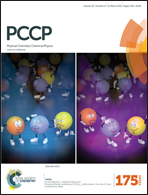Photodissociation dynamics of propyne at 193 nm: a trajectory surface hopping study
Abstract
Photodissociation dynamics of propyne at 193 nm are studied using the fewest switches nonadiabatic trajectory surface hopping method on its first excited singlet electronic state (11A′′). The trajectories are propagated based on potential energies, gradients and nonadiabatic couplings calculated at the MRCIS(6,7) level with the 6-31++G(d,p) basis set. Our trajectory calculations have revealed that H + H3CCC is the major dissociation channel, which has also been predicted experimentally. For the primary photodissociation channel H + H3CCC we demonstrate that nonadiabatic dynamics do not play a significant role. This observation is however contradictory to most of the previously reported experimental predictions. The calculated product translation energy distribution for the acetylenic H atom elimination peaked at ∼18 kcal mol−1, indicating that the dissociation occurs adiabatically on a moderately repulsive excited surface that correlates with the ground state products (CH3C![[triple bond, length as m-dash]](https://www.rsc.org/images/entities/char_e002.gif) C + H). The H atom elimination process from the methyl fragment involving a transition state, which has to compete with the acetylenic H atom dissociation channel with no barrier in the excited singlet surface, was found to be too less probable to make a contribution to product branching. We observed that a fewer but significant number of trajectories led to CH3 + CCH product formation which has not been observed experimentally when propyne is excited at 193 nm.
C + H). The H atom elimination process from the methyl fragment involving a transition state, which has to compete with the acetylenic H atom dissociation channel with no barrier in the excited singlet surface, was found to be too less probable to make a contribution to product branching. We observed that a fewer but significant number of trajectories led to CH3 + CCH product formation which has not been observed experimentally when propyne is excited at 193 nm.


 Please wait while we load your content...
Please wait while we load your content...